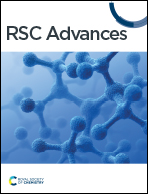Performance of ionic liquid functionalized metal organic frameworks in the adsorption process of phenol derivatives
Abstract
The growth of industrial activities has produced a significant increase in the release of toxic organic pollutants (OPs) to the environment from industrial wastewater. On this premise, this study reports the use of metal organic frameworks (MOFs) impregnated with various ionic liquids (ILs) in the adsorption of phenol derivatives, i.e., 2,6-dimethylphenol and 4,4′-dihydroxybiphenyl. MOFs were prepared starting from 1-hydroxyethylidene-1,1-diphosphonic acid (HEDP) with divalent (Co, Ni, Cu) and trivalent (Ce) metal salts in mild hydrothermal conditions using water as a green solvent. Imidazolium base ionic liquids, namely 1-butyl-3-methylimidazolium trifluoromethanesulfonate, 1-butyl-3-methylimidazolium nitrate, 1-butyl-3-methylimidazolium chloride, and 1-hexyl-3-methyl-imidazolium chloride, were used to modify MOFs, leading to composite materials (IL@MOF), which show the structural characteristics of MOFs, and complement the advantages of ILs. SEM, EDX images, and TG data indicate that the IL is just attached on the surface of the adsorbent material, with no changes in crystal size or morphology, but with slightly altered thermal stabilities of IL@MOF composites compared to the original ILs and MOFs, pointing to some interionic interaction between IL and MOF. This research consists of equilibrium experiments, studying the effect of the initial concentration of OPs on the adsorption efficiency of the as-prepared MOFs and IL@MOF, in order to determine the influence of the nature of the adsorbent on its developed adsorption capacity and to investigate the performance of both ILs and MOFs. To determine the maximum adsorption capacity, several empirical isotherms were used: Langmuir, Freundlich, Redlich–Peterson, and Dubinin–Radushkevich. The characteristic parameters for each isotherm and the correlation coefficient (R2) were identified. The IL modification of MOFs increased the adsorption capacity of IL@MOF for the removal of phenol derivatives from aqueous solution. The adsorption capacity function of the MOF structure follows the trend CeHEDP > CoHEDP > NiHEDP > CuHEDP. The best performance was achieved by adsorbent materials based on Ce.



 Please wait while we load your content...
Please wait while we load your content...